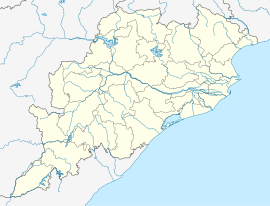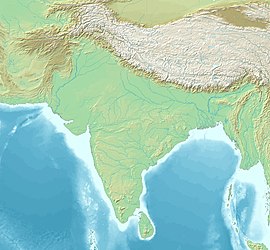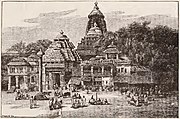Firoz Shah's invasion of Orissa
 From Wikipedia the free encyclopedia
From Wikipedia the free encyclopedia
| Firoz Shah's Invasion of Orissa | |||||||
|---|---|---|---|---|---|---|---|
| |||||||
| Belligerents | |||||||
| Delhi Sultanate | Eastern Ganga Dynasty Early Chauhans of Orissa | ||||||
| Commanders and leaders | |||||||
| Firoz Shah Tughlaq | Bhanudeva III Visaladeva Chauhan † | ||||||
| Strength | |||||||
| Unknown | Unknown | ||||||
| Casualties and losses | |||||||
| Unknown | 100000 Killed[3][4] | ||||||
Location within Odisha | |||||||
The military expedition launched by Emperor Firoz Shah Tughlaq against Orissa was a significant campaign aimed at dismantling the Eastern Ganga Dynasty. This operation formed part of a broader initiative by neighboring kingdoms to acquire the prized war elephants of Orissa noted for their strength and power.
In 1361, Firoz Shah Tughlaq orchestrated a major offensive against Orissa supported by the forces of the Delhi Sultanate. Bhanudeva III, a ruler hailing from the Eastern Ganga Dynasty, governed Orissa during this period. The military endeavor, strategically conducted following Firoz Shah Tughlaq's previous successful venture in Bengal, sought to assert dominance over Orissa and appropriate its valuable assets.
The expedition against Orissa unfolded as a ruthless and devastating campaign with the primary aim of subduing the kingdom and securing its coveted resources. The troops of the Delhi Sultanate engaged in an unyielding assault on Orissa, resulting in substantial setbacks for the Eastern Ganga Dynasty.
Ultimately, the military expedition against Orissa led by Firoz Shah Tughlaq stands as a pivotal event in the region's history, symbolizing a moment characterized by profound conflict and turmoil.
Background[edit]
In the early 14th century, rebellious governors in Bengal established their own sultanates separate from Delhi's rule. By 1352, Shamsuddin Ilyas Shah emerged victorious in Bengal, consolidating power by defeating other regional rulers and uniting the territory into a single sultanate. Proclaiming himself as the Sultan of Bengal, Ilyas Shah solidified his authority in the region.
In 1353, Sultan Firuz Shah Tughluq of Delhi led a formidable force of 70,000 men into Bengal, sparking a significant conflict between the Bengal Sultanate and the Delhi Sultanate. Despite a victory for Sultan Firuz Shah Tughlaq over Ilyas Shah, he subsequently granted him independence from Delhi's control.
Following this campaign, Sultan Firuz Shah Tughluq proceeded to march against Orissa, marking another pivotal military expedition orchestrated by the Delhi Sultanate.Bhanudeva III reigned as the monarch of Orissa and was a member of the Eastern Ganga Dynasty.[5]
The Expendition[edit]
In the year 1360 AD, Firuz Shah Tughlaq embarked on a military campaign, commencing from Jaunpur. He successfully conquered territories such as Panchet and Shikharabhum, alongside other tracts ending in "Bhum" within the Jungle Mahals region. Progressing further, he advanced towards Jajnagar during the reign of Bhanudeva III. The historical accounts indicate that Firuz Shah opted to follow ancient trade routes, passing through Orissa and extending to the Jungle Mahals via the districts of Midnapore and Bankura.
Firuz Shah Tughlaq advanced his forces all the way to Puri, where King Bhanudeva III bravely confronted the sultan's army.[3][6]However, after a brief engagement, Bhanudeva III was defeated and subsequently fled to the forests for sanctuary.[7] [2]Eventually, he emerged and decided to submit to Sultan Firuz Shah, offering a tribute in the form of several elephants.[8][9][10]
The king, named Visaladeva Chauhan, who ruled in Sambalpur, Orissa, was defeated and killed in battle. His pregnant wife managed to escape with her life.[11][12]
Destruction of Jagannath Puri[edit]
- Map of Delhi Sultanate
- Eastern Gangas
It has been known for some time that there was a temple of Jagannatha (Purusottama) located at Banarasi (now known as Cuttack), the capital of the Orissan kingdom of the Gangas. Historical records, such as the Tarikh-i-Firoz Shahi, mention an expedition led by Sultan Firoz Shah Tughlaq of Delhi against the Eastern Ganga Dynasty around 1360 A.D. The Ganga king at that time, Bhanudeva III, had his headquarters at Banarasi (Cuttack). During this expedition, the Sultan occupied Banarasi while the king had fled. The Tarikh-i-Firoz Shahi also mentions that inside the king's fort in Banarasi (Cuttack), there was a stone idol called Jagannath Puri, which the local people worshipped.[13][14] Sultan Firuz Shah Tughlaq, following the example of Mahmud of Ghazni, removed the idol and took it to Delhi, where it was placed in a disrespectful manner.
Recent evidence suggests that the image of Jagannatha at Cuttack was actually installed by the Ganga king Anangabhima III. This further highlights the significance of the temple and the idol of Jagannatha in the region during that time.[15][16]
Aftermath[edit]
During the expedition, approximately one hundred and twenty thousand inhabitants were killed. The Jagannath Puri temple was completely destroyed, and its idol was taken to Delhi. Bhanudeva III appeared and presented some elephants as tribute, agreeing to pay an annual tribute of 20 elephants. Following this, Firoz Shah Tughlaq returned to Delhi.[17][18][1]
References[edit]
- ^ a b Chakraborty, Rabindra Nath (1985). National Integration in Historical Perspective: A Cultural Regeneration in Eastern India. Mittal Publications. p. 18.
- ^ a b Rahman, Syed Amanur; Verma, Balraj (2006). The Beautiful India - Orissa. Reference Press. p. 52. ISBN 978-81-8405-005-9.
- ^ a b Agarwal, M. K. (2012). From Bharata to India: Volume 2: The Rape of Chrysee. iUniverse. p. 160. ISBN 978-1-4759-0768-1.
- ^ Baker, William Richard. A deadly religion. Lulupublisher. p. 44. ISBN 978-1-4461-3669-0.
- ^ PANIGRAHI, KRISHNA CHANDRA (2023-01-05). History of Orissa: (HINDU PERIOD). Notion Press. ISBN 978-1-68586-798-0.
- ^ Baker, William Richard. A deadly religion. Lulupublisher. p. 44. ISBN 978-1-4461-3669-0.
- ^ Lahiri, Aloka (1993). Chaitanya Movement in Eastern India. Punthi Pustak. p. 14. ISBN 978-81-85094-67-0.
- ^ Panda, Shishir Kumar (1999). Political and Cultural History of Orissa. New Age International. pp. 199–201. ISBN 978-81-224-1197-3.
- ^ Pradhan, Atul Chandra (1984). A Study of History of Orissa: From the Earliest Times to Mukundadeva. Panchashila. pp. 85–87.
- ^ Kainikara, Dr Sanu (2018-06-11). From Indus to Independence - A Trek Through Indian History: (Vol V The Delhi Sultanate). Vij Books India Pvt Ltd. ISBN 978-93-86457-73-8.
- ^ Kulke, Hermann; Sahu, Bhairabi Prasad (2022-01-13). The Routledge Handbook of the State in Premodern India. Taylor & Francis. p. 403. ISBN 978-1-000-48514-1.
- ^ Shukla, Hira Lal (1985). Language, Ethnicity, and History: Dimensions in Anthropological Linguistics. B.R. Publishing Corporation. p. 108. ISBN 978-81-7018-239-9.
- ^ Agarwal, M. K. (2012). From Bharata to India: Volume 2: The Rape of Chrysee. iUniverse. p. 160. ISBN 978-1-4759-0768-1.
- ^ Baker, William Richard. A deadly religion. Lulu.com. p. 44. ISBN 978-1-4461-3669-0.
- ^ Sircar, Dineschandra (1971). Studies in the Religious Life of Ancient and Medieval India. Motilal Banarsidass Publ. pp. 70–71. ISBN 978-81-208-2790-5.
- ^ "Wayback Machine" (PDF). web.archive.org. Archived from the original on 2014-07-14. Retrieved 2024-03-27.
{{cite web}}: CS1 maint: bot: original URL status unknown (link) - ^ Kulke, Hermann; Rothermund, Dietmar (1998). A History of India. Psychology Press. p. 173. ISBN 978-0-415-15482-6.
- ^ Luniya, Bhanwarlal Nathuram (1978). Life and Culture in Medieval India. Kamal Prakashan. p. 471.





